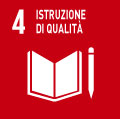- Docente: Paolo Garofalo
- Crediti formativi: 9
- SSD: GEO/09
- Lingua di insegnamento: Inglese
- Modalità didattica: Convenzionale - Lezioni in presenza
- Campus: Bologna
- Corso: Laurea Magistrale in Geologia per lo sviluppo sostenibile (cod. 6050)
-
dal 25/02/2025 al 11/06/2025
Conoscenze e abilità da conseguire
The objective of this course is giving a system and integrated view of the geological processes that lead to the genesis of the main primary raw materials using a combination of field, laboratory, and numerical methods. The fundamental subjects of this course will be the geological characteristics of the most important classes of ore deposits, which include the magmatic, magmatic-hydrothermal, hydrothermal exhalative, orogenic-Au, Mississippi valley type, banded iron formations (BIF), and placer deposits. The geothermal fields will be considered as proxies of currently forming ore deposits. The scientific methods used in the course will be field mapping of ore bodies and wallrock alteration, the petrographic, mineralogical, and geochemical study of ore bodies and wallrock alteration; the fluid inclusion studies; stable isotope studies; fluid-rock equilibria. At the end of the course, the students will learn how to distinguish and identify with various techniques samples from different deposit types.
Contenuti
What is an ore deposit. Classification and deposit models.
Introduction to tools for styding the genesis of ore deposits: field documentation; reflected light microscopy; fluid inclusion microthermometry.
Magmatic ore deposits: deposits formed by small fractionation of partial melts (LREE); deposits formed during differentiation of a silicate melt (chromite); deposits formed via extreme fractionation of magma (rare-metal pegmatites).
Hydrothermal deposits formed around magmatic centers: porphyry deposits; skarn deposits; high- and low-sulfidation epithermal deposits; volcanogenic massive sulfide deposits.
Orogenic Au deposits.
Hydrothermal deposits formed in sedimentary environments: Mississippi Valley type deposits; SEDEX Pb-Zn-Ag deposits; Kupferschiefer deposits.
Ore deposits formed in sedimentary environments: iron ores and ironstones; Placers and paleoplacersTesti/Bibliografia
Ridley J. (2013). Ore Deposit Geology. Cambridge University Press.
Additional reading will be distributed in the classMetodi didattici
Classes;
Laboratory excercies;
Fieldwork;
SeminarsModalità di verifica e valutazione dell'apprendimento
Different assessment methods will be used to evaluate the students: content-based, competence-based and impact-based assessments. Content-based assessment refers to assessment tasks that mainly ask the learner about facts. Competence-based assessment refers to assessments of intended learning outcomes that ask the learner to show ability to also use these facts. Impact-based assessments take the assessment of competencies one step further and ask the learner to use these competencies in a real-life situation to create a change or solve a challenge.
Class participation: 10%
Lab / fieldwork: 30%
Written outputs: essay or laboratory exercise: 30%
Oral exam: 30%Strumenti a supporto della didattica
Laboratory excercises;
Reflected light petrographyic analysis;
Seminars provided by external instructors from academia and industry
Orario di ricevimento
Consulta il sito web di Paolo Garofalo
SDGs



L'insegnamento contribuisce al perseguimento degli Obiettivi di Sviluppo Sostenibile dell'Agenda 2030 dell'ONU.
